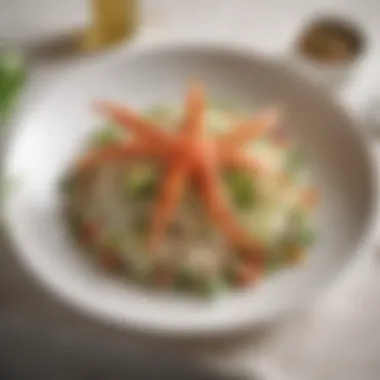Exploring Imitation Crab Salad: A Comprehensive Guide


Intro
Imitation crab salad is a dish that captures the essence of seafood without the need for its more perishable counterparts. This dish serves as a perfect blend of taste, texture, and nutrition. It is often appreciated for its versatility, making it suitable for various occasions, from casual lunches to elaborate dinners.
At its core, imitation crab salad is a delightful mixture of imitation crab meat, which is primarily made from surimi, a processed seafood product, along with a range of vegetables and dressings. As a result, it can cater to both the health-conscious and the indulgent eater, depending on the ingredients and preparation methods used. The next sections will provide a thorough overview and guide on this dish, detailing essential ingredients, cooking methods, and various serving suggestions.
Recipe Overview
Brief description of the dish
Imitation crab salad blends the mild, sweet flavor of imitation crab with crunchy vegetables and a creamy dressing. It can be served in multiple ways, such as on a bed of greens, in a sandwich, or as a filling for wraps. The beauty of this salad lies in the ease of preparation, making it an excellent choice for both beginner cooks and experienced chefs.
Ingredients list
The simplicity of imitation crab salad is one of its appealing features. Here are the primary ingredients that typically compose this dish:
- Imitation crab meat, shredded or chopped
- Mayonnaise or a yogurt-based dressing
- Celery, diced
- Red onion or shallots, finely chopped
- Bell peppers, diced
- Fresh herbs like dill or parsley
- Lemon juice for a touch of acidity
- Salt and pepper to taste
Optional ingredients can include avocado, corn, or even diced apples for a touch of sweetness.
Step-by-Step Cooking Instructions
Detailed cooking process
- Prep the vegetables: Start by washing and chopping all the fresh vegetables. Make sure to cut them into uniform sizes for even mixing.
- Mix the imitation crab: In a large bowl, add your chopped imitation crab meat. If you're using a block or a large amount, consider shredding it into bite-sized pieces.
- Combine ingredients: Add the chopped vegetables to the bowl with the crab meat. This is where the salad begins to take shape, so be generous with your choices of veggies.
- Add the dressing: In a separate small bowl, mix the mayonnaise with the lemon juice and any desired herbs. Once mixed, pour it over the crab and vegetable mixture, stirring gently until everything is well-coated.
- Season: Finally, add salt and pepper to taste. Taste-test the salad and adjust accordingly.
- Chill before serving: For an enhanced flavor, refrigerate the salad for at least an hour before serving. This allows flavors to meld together.
Useful tips for each step
- When chopping vegetables, keep them consistent in size. This promotes even distribution throughout the salad.
- For those who prefer less creamy salads, using a yogurt-based dressing is lighter but still maintains a desirable taste.
- If you want to experiment, try adding unique ingredients such as mango or jalapeños for a twist.
Imitation crab salad is not just a dish; it is an experience that combines flavor profiles while remaining accessible to all.
In summary, imitation crab salad offers a simple yet satisfying way to enjoy a salad that celebrates the sublties of seafood flavors. With the flexibility in ingredients and methods, it is easy to personalize according to tastes and dietary preferences.
Understanding Imitation Crab
Imitation crab merits attention due to its versatile nature and widespread use in various dishes. A proper grasp of this ingredient lays the foundation for crafting delightful meals, particularly salads. Understanding its composition can guide choices in flavor profiles and nutritional balance.
What Is Imitation Crab?
Imitation crab is a seafood product designed to mimic the taste and texture of real crab meat. Typically made from a type of fish called surimi, it offers an economical alternative for seafood lovers. Imitation crab does not use actual crab but provides a similar culinary experience.
Ingredients in Imitation Crab
Surimi
Surimi is a crucial component in the creation of imitation crab. It is a fish paste, processed to have a mild flavor and a pleasing texture. The key characteristic of surimi is its ability to absorb flavors, allowing for a versatile use in various recipes. Its appeal lies in its affordability and mildness, making it a staple in many kitchens. The unique aspect of surimi is its processing, where fish is finely minced, washed, and further processed to create a paste, ensuring consistency in quality and texture. However, some may find that surimi lacks the depth of flavor found in fresh seafood.
Other Additives
The inclusion of other additives in imitation crab helps to enhance its flavor and shelf-life. Common additives include starches, sugars, and artificial flavors. These substances are beneficial as they not only improve texture but also contribute to the product's longevity. A notable feature of these additives is that they can make imitation crab more appealing to consumers, often resulting in a sweeter taste. However, reliance on these additives may result in a product with a different nutritional profile compared to natrual crab.
Nutritional Information
Imitation crab generally contains fewer calories and fat compared to real crab. This aspect makes it attractive for those mindful of their dietary intake. A distinguishing feature is its protein content, typically lower than that of natural crab, making its nutritional profile somewhat unique. While the calorie count may be beneficial for some, the reduced protein levels may deter others seeking higher protein options. Moreover, understanding the nutritional information helps consumers make informed choices, particularly in diet planning.
Origin and History
The origin of imitation crab traces back to Japan during the 1970s, where surimi was famously developed. Initially, it aimed to utilize underused fish species, allowing for sustainable seafood options. Over time, imitation crab gained popularity in Western countries, often appearing in various dishes. Understanding this history enhances the appreciation of its culinary versatility today.


The Fundamentals of Imitation Crab Salad
The creation of an imitation crab salad starts with understanding its foundational components. This section is key because it lays the groundwork for how this dish is prepared, its flavor profile, and what makes it appealing to diverse audiences. Knowing the role of each element allows for better manipulation and customization of recipes, making it versatile enough to suit various tastes and dietary preferences.
Basic Components of Imitation Crab Salad
Base Ingredients
The base ingredients form the core of any imitation crab salad. Most commonly, imitation crab consists of surimi, a processed fish product that mimics the texture and taste of real crab meat. Surimi is generally made from white-fleshed fish like Alaskan pollock, which provides a mild flavor that many find appealing. This choice of ingredient is beneficial in this article as it is not only cost-effective but also widely available, making the dish accessible to many home cooks.
The unique feature of surimi is its ability to absorb flavors from added ingredients, enhancing the overall taste of the salad. However, its quality can vary significantly between brands. Hence, selecting a reputable brand ensures a better culinary experience. Cheap options sometimes contain fillers that can affect both taste and texture negatively.
Dressing Options
Choosing the right dressing is essential for elevating the flavors of imitation crab salad. Common options include mayonnaise, sour cream, and various vinaigrettes. Mayonnaise, for example, imparts creaminess and richness, making it a popular choice in many recipes. This aspect serves a great purpose in the article, as it directly affects the enjoyment of the dish.
One unique feature of dressings is their versatility. You can create lighter versions using yogurt or add spices to bring out vibrant flavors. However, it is important to consider that overusing heavy dressings can overpower the taste of the base ingredients. Therefore, achieving a balance is crucial for preserving the integrity of the salad.
Preparation Techniques
Chopping Techniques
Proper chopping is vital for achieving an appealing texture in the salad. Whether you choose to dice or shred the ingredients can greatly influence the mouthfeel. For instance, finely chopped vegetables like celery and bell pepper can enhance the crunch, contributing positively to the overall experience. This attention to detail matters because it can elevate what might otherwise be a standard dish into something memorable.
A unique aspect of chopping is the uniformity in size. Similar-sized pieces ensure even distribution of flavor throughout the salad. However, one should be careful not to chop too finely, as it may lead to a mushy texture. This timing and technique can dramatically impact the final product.
Mixing Instructions
Mixing the ingredients properly is the next step in perfecting imitation crab salad. The key characteristic of mixing is to gently combine the ingredients so that they are evenly distributed without crushing them. This is especially crucial for any added vegetables. A rigorous mixing technique can damage delicate items, leading to an unappealing texture.
Using a large bowl and a spatula is advised for effective mixing. This choice allows for thorough incorporation of each element without overwhelming them. One potential downside of mixing too aggressively is that it can make the salad appear unattractive, detracting from its presentation. Therefore, a gentle touch is recommended to maintain both flavor and appearance.
"Understanding these fundamental aspects of imitation crab salad not only aids in preparation but also enhances the culinary experience for everyone involved."
Nutritional Aspects of Imitation Crab Salad
The nutritional landscape of imitation crab salad is essential to understand, especially for those seeking healthy meal options. This salad combines the appealing texture of imitation crab with various ingredients, providing a balance of flavor and nutrition. As we discuss the caloric content, protein levels, as well as vitamins and minerals, consider how each aspect contributes to its overall health benefits.
Caloric Content
When evaluating the caloric content of imitation crab salad, it is important to determine the total calories per serving. Typically, imitation crab meat contains fewer calories than genuine crab. A standard serving provides around 80 calories. However, the additional components of the salad, such as dressing and vegetables, can impact the overall caloric total. It's critical to examine the caloric values of the dressing used. Options like mayonnaise can significantly increase the calories, while lighter dressings, such as vinaigrettes, will not.
Protein Levels
The protein levels found in imitation crab salad can provide a substantial boost to daily nutritional intake. Imitation crab, primarily made from surimi, offers around 7 grams of protein per serving. This makes it a decent source of protein for individuals looking to consume lower-calorie meals without sacrificing essential nutrients. Balancing the protein levels with additional ingredients like chopped eggs or Greek yogurt can further enhance the protein content, making the salad more satisfying.
Vitamins and Minerals
Vitamins and minerals are vital components of any diet, and imitation crab salad can serve as a source for several essential nutrients. Imitation crab is often fortified with various vitamins, including B vitamins, which are crucial for energy metabolism. Additionally, including vegetables in the salad, such as bell peppers or celery, contributes fiber, vitamin C, and other micronutrients. Some variations might incorporate fruits like mangoes, which can introduce additional vitamins while adding a contrast to the salad’s overall flavor.
A well-rounded imitation crab salad not only satisfies hunger but also provides nutritional benefits essential for overall health.
Variations on Imitation Crab Salad
Imitation crab salad is not limited to a single recipe. Variations on imitation crab salad explore creativity and cater to different tastes and dietary needs. Such adaptations elevate this dish, making it versatile and appealing to a wider audience. Understanding these variations allows both novice cooks and seasoned chefs to customize the salad according to preferences and seasonal availability.
Classic Variations
With Vegetables
Adding vegetables to imitation crab salad enhances its texture and nutritional profile. Popular choices include bell peppers, celery, and cucumbers. These additions provide crunchiness and freshness. The inclusion of these vegetables balances the flavors, making it a delightful dish for the sense.


Key Characteristic: The variety of textures contributed by the vegetables.
Why It's Beneficial: Adding vegetables elevates the salad from a simple dish to a more nourishing option. Its ability to incorporate seasonal produce allows for creativity in preparation.
Unique Feature: The flavor profile can be customized based on the vegetables used. For example, snap peas can contribute sweetness, while radishes add a peppery kick.
Advantages/Disadvantages: While adding vegetables increases its health benefits, it also requires more preparation time and may affect the salad's overall cohesiveness.
With Fruits
Fruits bring an unexpected twist to imitation crab salad. Options such as mango, apple, or grapes can be excellent additions. They infuse the salad with sweetness, creating an appealing contrast to the savory taste of imitation crab. This combination can enhance the dish's complexity.
Key Characteristic: The balance of sweet and savory flavors.
Why It's Beneficial: Fruits not only improve the taste but also add vitamins and fiber, promoting a healthier meal. Combining fruity ingredients introduces a refreshing element, particularly suitable for warm weather.
Unique Feature: The type of fruit used significantly influences the salad's flavor profile. For instance, a tropical flair can be introduced with pineapple, while tartness can come from green apples.
Advantages/Disadvantages: The challenge may lie in selecting fruits that hold up well within the salad without becoming mushy. Furthermore, balancing the sweetness can be tricky, potentially overpowering the crab flavor.
Regional Variations
Asian-Inspired Recipes
Asian-inspired recipes infuse imitation crab salad with unique flavors and ingredients. Using sauces such as soy sauce or sesame oil can provide depth and umami. Adding ingredients like shredded carrots, cucumber, or even seaweed can enhance authenticity, creating a vibrant dish.
Key Characteristic: The fusion of flavors rooted in Asian cuisine.
Why It's Beneficial: Asian-inspired variations appeal to those seeking bold flavors. They offer opportunities to explore new taste profiles, making the dish exciting.
Unique Feature: The incorporation of sauces and spices can quickly transform the salad into a different culinary experience, appealing to adventurous eaters.
Advantages/Disadvantages: It may not be suitable for those who prefer traditional flavors. Additionally, not everyone may enjoy the saltiness or strong taste profiles present in some Asian ingredients.
Western Versions
Western variations of imitation crab salad tend to focus on creamy textures. Ingredients such as ranch dressing, mayonnaise, or even yogurt are prevalent. Common additions include ingredients like onions or dill, which complement the crab flavor nicely.
Key Characteristic: Creaminess and comforting flavors.
Why It's Beneficial: Western versions are popular for their accessibility and familiarity. It allows for ease of preparation and appeals to various palates, making it a crowd-pleaser.
Unique Feature: Creamy dressings can coat the ingredients well, ensuring that every bite is flavorful.
Advantages/Disadvantages: While creamy versions are well-liked for taste, they can be less healthy due to high calorie content from dressings. Finding a balance between taste and health is a crucial consideration.
Serving Suggestions
Serving suggestions play a pivotal role in enhancing the enjoyment of imitation crab salad. Properly presenting the dish can elevate its aesthetic appeal, making it more inviting. When cooked well, the flavors of imitation crab can shine through. Consider not just taste but also how texture and color can create a more vibrant culinary experience. These suggestions will help in creating a cohesive meal.
Plating Techniques
Plating techniques are crucial when serving imitation crab salad. A well-plated dish creates a visual feast. Start with a clean plate; white or light-colored plates work best to highlight the colors of the salad. Layer the ingredients rather than mixing them all together. For instance, you can place the imitation crab at the center, surrounded by colorful vegetables such as bell peppers and cucumbers. Garnishing with fresh herbs like dill or cilantro can also enhance the look and flavor.
- Stacking: This technique adds height and dimension. Layer crabs, avocado, and toppings in a tower.
- Saucing: Use a drizzle of dressing on the plate. This can provide extra flavor and an elegant appearance.
- Functional use of garnishes: Not only do they add beauty, but they can introduce new flavor profiles.
Pairing with Other Dishes
Pairing imitation crab salad with other dishes can enrich the meal and offer complementary flavors. Two popular categories for pairing are salads and breads.


Salads
Including other salads alongside imitation crab salad can add variety and depth. A fresh green salad featuring mixed greens or maybe a tangy coleslaw can contrast the texture of the crab salad. The refreshing aspect of salads promotes lightness, making it a beneficial choice.
- Key characteristic: Salads bring crispness and balance to the meal.
- Unique feature: Salads can be tailored to suit personal taste preferences, which is an advantage. However, using too many dressings can compete with the flavors of imitation crab salad.
Breads
Breads are another excellent pairing for imitation crab salad. Their soft and hearty texture complements the lightness of the salad. Options like croissants or sourdough bread can provide a nice contrast.
- Key characteristic: Breads can soak up dressings and flavors from the salad.
- Unique feature: Different breads can enhance the overall dining experience. However, stale bread can detract from the enjoyment, making freshness a vital consideration.
Common Mistakes to Avoid
In the realm of culinary endeavors, some common pitfalls can derail even the most well-intentioned attempts at making imitation crab salad. Recognizing these mistakes can enhance the overall experience and outcome of this dish. Avoiding these errors not only guarantees a better taste but also ensures that the health benefits of the ingredients shine through.
Over-Seasoning
One of the most frequent mistakes in preparing imitation crab salad is over-seasoning. The imitation crab itself has a mild flavor. Adding excessive spices or overly strong dressings can overpower this subtle taste. It is important to remember that balance is key.
When seasoning, take a measured approach. Start with small amounts of seasoning and adjust as needed. A pinch of salt and some freshly cracked pepper might enhance flavors without dominating them. Citrus, like lemon or lime juice, can also elevate freshness without making the dish overly salty or spicy.
To achieve the right balance:
- Use seasoning in moderation.
- Taste the mixture frequently as you combine ingredients.
- Consider the other flavor components in your salad. If you include ingredients like onion or garlic, reduce other strong seasonings accordingly.
In general, remember that it is easier to add more seasoning than to remove it once it has been integrated. Therefore, restraint is advisable when crafting your salad.
Using Poor Quality Imitation Crab
Another significant error is the utilization of poor quality imitation crab. The texture and flavor can vary widely among different brands and products. Opting for a lower-quality imitation crab can result in a dish that lacks the desired culinary satisfaction.
When purchasing imitation crab, look for brands that emphasize fresh ingredients and proper processing methods. This often translates into a better taste and texture. Moreover, higher quality options tend to contain fewer fillers and additives, which is benefitting for both flavor and nutrition.
Consider these points when selecting imitation crab:
- Check the Ingredient List: Aim for products that list surimi as the primary ingredient without excessive additives.
- Assess Visual Appearance: Quality imitation crab should have a natural look, without excessive colorings or preservatives.
- Read Reviews: Online resources, like forums on Reddit or product reviews on e-commerce sites, can provide insight into the best options available.
By avoiding these misunderstandings, you can ensure that the final product is not only delicious but also a genuine representation of what imitation crab salad should be. This reflection can elevate the dish from just a meal to an enjoyable and memorable experience.
Storage and Safety Tips
Storing imitation crab salad properly is crucial for both safety and quality. As a prepared dish, it can harbor bacteria if not handled correctly. Understanding how to store and manage this salad can help maintain its flavors and prevent potential foodborne illnesses. Here, we will outline the essential practices required for refrigeration and freezing to enjoy this dish safely.
Refrigeration Guidelines
Imitation crab salad should be stored in the refrigerator if it is not consumed right away. Here are some general guidelines to follow:
- Temperature: Keep the refrigerator at or below 40°F (4°C). This temperature slows the growth of bacteria.
- Storage Container: Use airtight containers to keep the salad fresh. Plastic or glass containers work equally well.
- Duration: Consume the salad within 3 to 5 days of preparation. After this time, the quality decreases, and risks increase.
- Leftovers: If you plan to store leftovers, allow the salad to cool at room temperature for a short period before placing it in the refrigerator. This helps prevent condensation that can lead to spoilage.
Freezing Imatation Crab Salad
Freezing imitation crab salad is an option, though it may alter the texture of certain ingredients. Here’s what you should consider when freezing:
- Freezing Process: Place the salad in a freezer-safe, airtight container. Be sure to leave space for expansion as the contents freeze.
- Ingredient Considerations: Some ingredients, like mayonnaise, do not freeze well. It is often best to freeze without dressing and add it fresh after thawing.
- Duration: For best quality, consume the salad within 1 to 2 months after freezing. While it may be safe to eat after this time, the flavors and textures can degrade.
- Thawing: To thaw, transfer the container from the freezer to the refrigerator. Allow it to thaw for several hours or overnight.
End
The conclusion serves as a critical component of this article, summarizing key points while reinforcing the significance of imitation crab salad in culinary practices. By reviewing what has been discussed, readers are given a refreshing opportunity to consolidate their understanding of both the ingredients and preparation methods. This further emphasizes the versatility of imitation crab salad, showcasing it as a familiar yet adaptable dish.
Imitation crab salad not only offers a delightful balance of taste and texture but also serves as a nutritious option for various palates. The importance of knowing how to create different variations allows food lovers to explore and personalize the dish according to their preferences. Moreover, the guidance offered on storage and safety can boost confidence for home cooks, ensuring that the dish is prepared and enjoyed without compromise.
Recap of Key Points
- Understanding of Ingredients: The article elaborates on the components of imitation crab and its nutritional benefits, emphasizing how it can fit into a balanced diet.
- Preparation Techniques: Readers are equipped with valuable skills on how to chop vegetables, mix ingredients, and create a well-composed salad.
- Variations: The exploration of regional and classic variations inspires creativity, allowing individuals to adapt the dish to their tastes.
- Serving Suggestions: Recommendations on plating and pairing elevate the dining experience, enhancing presentation and flavor combinations.
- Common Mistakes: A thorough understanding of potential pitfalls helps prevent novice cooks from ruining this delightful dish.
- Storage Tips: Knowing how to properly store imitation crab salad ensures freshness and safety, prolonging its usability.
Overall, this comprehensive guide on imitation crab salad enriches the culinary repertoire of food lovers, making it both a relevant and enjoyable addition to home cooking.







